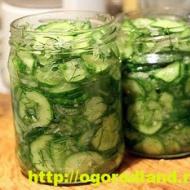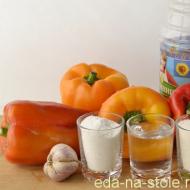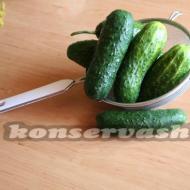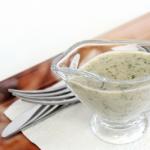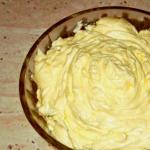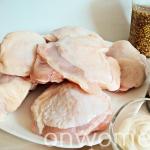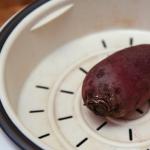
Pickled cucumbers and tomatoes together in a barrel. Pickled cucumbers with tomatoes for the winter
SALVATION OF CUCUMBERS IN BARRELS.
Prepared for pickling cucumbers must be sorted by size and salt each size separately. Salting cucumbers is better than small and medium-sized regular shape, not over-ripe and without damaged surfaces. After sorting, pour fresh cucumbers with cold water in the tank, pelvis, bucket and withstand 2-2.5 hours. If the vegetables are bought in the store, they are recommended to be held in cold water for at least 4-5 hours. Water for salting is better to use well or spring.
Before you start laying cucumbers, you must prepare all the spices. For pickling cucumbers in barrels use: dill, garlic, black currant leaf, cherry leaf, pepper, tarragon, horseradish leaves or horseradish root itself. Spices wash well in water. Garlic should be cleaned from matte scales, washed and finely chopped, without peeling the teeth from the skin, lightly salt and crush with wooden pulp. Dill and tarragon are cut into pieces with a length of 8-10 centimeters, horseradish root is cut into small strips, and the leaves are laid intact. Tarragon for pickling cucumbers taken at the beginning of flowering, and dill in the stage of formation of green seeds.
- 3 kg of dill;
- 0.5 kg horseradish (horseradish leaves must be freshly picked);
- 0.3 kg of garlic;
- 50 g dry bitter peppers;
- 0.3 kg of tarragon;
- 0.5 kg of black currant leaves;
- 0.5 kg of cherry leaves.
The number of all spice plants should not exceed 5% by weight of cucumbers.
We start to lay spices. First, with the prepared garlic we well wipe the bottom and walls of the barrel, then we line them with horseradish leaves. Put a layer of other spicy plants on the bottom (1/3 of the total amount envisaged by the recipe) and stack the cucumbers in dense rows, placing them vertically. Filling half the barrel, add another third of the spices and re-stack the cucumbers before it is finally filled. On top of the cucumbers put the rest of the spicy plants, and on top of the leaves of horseradish. Filled barrels are capped with pre-prepared lids or put a wooden circle, and the oppression (load) is poured on it and filled with brine.
For the preparation of brine is good to use hard drinking water. Per 100 kg of medium cucumber requires 20 liters of brine. Salt is dissolved in a separate container, in warm water (at a temperature of 35-40 degrees). Then the brine is filtered through a dense fabric and poured into a barrel so that the cucumbers are completely covered with it.
Brine strength for cucumbers of different sizes should be different. Small and medium-sized brine is poured at the rate of 700 g of table salt for every 10 liters of water, and for large ones (longer than 10 centimeters) they take 800 g of salt per 10 liters of water. If cucumbers are stored in a warm room, the amount of salt increases to 800-850 g per 10 liters of water.
Fill the barrel with pickle pickles in a room with a room temperature of 15-18 degrees and leave for 2-3 days for pre-fermentation and refill with brine as needed. During this time, about 1/3 of the total amount of lactic acid is formed, which is quite enough to suppress putrefactive bacteria. Then the barrels of cucumbers are transferred to a cold basement, cellar, and best of all in the glacier and stored at a temperature of from 0 to 5 degrees Celsius. Here the fermentation process continues, but it proceeds more slowly, usually ending in 30-40 days. Now the cucumbers are ready. They get a pleasant smell, salty-sour taste, green-olive color. Their flesh is dense, crunchy.
When stored in adverse conditions (with high air temperature), cucumbers can acquire an unpleasant, putrid odor. In this case, you need to put sugar beets, which are raw in a vegetable grater, in a barrel, and the smell disappears in 2-3 days. Sugar beet gives cucumbers a fortress and protects them from spoilage. Some in advance put it on the bottom of the barrel at the rate of 2-3 kg per 100 kg of cucumbers.
SALTED TOMATOES IN BARRELS
First of all, tomatoes need to be carefully sorted. All fruits are sorted, choosing tomatoes of the same degree of ripeness and approximately the same size. Tomatoes of the same quality are well saturated with pickle and will keep their shape better. They should be sorted by size and color, remove damaged and crumpled, cleaned from the stalks, rinsed in running water. The density of fruits in the finished product depends on their degree of maturity. For this reason, pink and red tomatoes are best salted in small containers of 10-15 liters, brown ones in containers of 25-50 liters, green ones in containers of 100 liters Red tomatoes should be salted on the harvesting day, brown and greens can be stored until salted 2 -3 days in a cool dark place.
To pickle tomatoes you will need:
- 10 kg of tomatoes;
- 150-200 g of dill;
- 100 g of black currant leaves;
- 40 g parsley and celery leaves;
- 10 grams of fresh or 2 grams of chilli peppers;
- 50 g of tarragon or parsley leaves;
- 50 g horseradish leaves;
Brine:
- 8 liters of water
- 400 g salt
For salting tomatoes use: dill, black currant leaves, parsley and celery, pepper, tarragon, horseradish leaves. Spicy greens: dill, parsley, celery need to sort, remove the yellowed leaves, thickened stems, wash, let the water drain, cut the celery into pieces 10 cm long, and lay black currant leaves and horseradish. Dill and parsley should be put in the pot with whole plants (not chopped) to prevent piercing the tomatoes.
If desired, you can add marjoram, bay leaf and other spices. When salting horseradish can be replaced with dry mustard, which gives strength to these vegetables and protects the brine from mold. At 10-12 liters of brine put 200-250 g of dry mustard. Water for brine is better to use boiled.
Two layers of black currant leaves are placed at the bottom of the barrel, 1/3 of the spices remaining in the recipe, and then the tomatoes are laid in rows (stem up) to half the capacity, because the taste of salted tomatoes at the same brine concentration depends on the density of fruit placement. Loosely laid tomatoes can get salty. In the middle of the barrel put the second part of the spices, and then the tomatoes. Put the remaining spices on top.
Fill the barrel filled with brine. There are two ways. In the first case, the tomatoes in a barrel are covered with a napkin, over which a wooden circle with a diameter slightly less than a barrel is laid. A load is placed on it and then a brine is poured over the barrel, which penetrates down through the small gaps between the circle and the walls of the barrel. The second option provides for complete clogging of the barrel using the top bottom with a tongue-and-groove hole, through which the brine is poured.
The strength of the brine depends on the degree of maturity of the fruit. For green and brown fruits, salt takes 600-700 g per 10 liters of water, and for red and pink 800-850 g it is recommended to pour green tomatoes with hot brine.
We hold filled containers for 2-3 days, at a temperature of 18-20 ° C. In the first three days, active fermentation takes place in the barrel. During this period, the tank is periodically refilled with brine until all the foam comes out. After the end of fermentation, the brine should become sufficiently transparent, with only a slight turbidity from the presence of lactic acid bacteria. Then move to a cool place and store at a temperature of from 0 to + 5 ° C. Mold that appears on the surface must be removed periodically. The appearance of mold can be avoided if the surface of the brine pour 1-2 tbsp. spoons of vegetable oil.
A month after salting, the tomatoes in the cellar are ready for use. For 30 days, the juicy fruits of tomatoes are saturated with an aromatic pickle and become unusually tasty.
There is a dry way of salting tomatoes in a barrel.
For the dry method of salting tomatoes choose ripe fruits without cracks and dents. Tomatoes are washed and dried. All spices for salting also washed and crushed.
Take 700 g of coarse salt per 10 kg of fresh tomatoes.
A layer of salt is laid on the prepared dry barrel on the bottom, a floor of tomatoes is laid on it, a layer of tomatoes is carpeted with spices and covered with a new “salty” floor. Thus, tomatoes, spices and salt fill the entire space of the barrel. The full wooden container is set aside in a cold place. Red fruit in a week will give the juice, which will dissolve the layer of salt.
A generously arriving pickle should cover all tomato floors. In order for the top layer of tomatoes not to become covered with mold, lightly sprinkle it with dry mustard and tightly close the wooden container after that.
KASHAST KABASTY IN BARRELS
Sauerkraut is very useful, it is rich in vitamins and other nutrients, unlike fresh cabbage.
To get good sauerkraut, its variety and fresh quality are important. There are many types of cabbage. Cabbage differs not only in appearance, but in taste and content in its composition of various substances. Any cabbage is a source of vitamin C. Usually middle-ripening and late-ripening varieties of white cabbage usually ferment. White cabbage is always in demand and is very well stored. Heads pick quite mature, clean, without any diseases. After cleaning the cabbies should lie down - whiten. After that you can sour.
They are cleaned from the top green cover leaves with a kitchen knife, cut out the stalk and chopped on special shredding boards, with a wide kitchen knife or chopped in a wooden trough with special cuts. At the same time, the chips should be uniform, at least 6 cm long and 3-4 mm wide, and when cut, pieces with a diameter of 1-1.5 cm. Carrot is also prepared at the same time as shredding cabbage. It is pre-soaked in cold water and thoroughly removes dirt. Peeled carrots are also chopped into chips 5 mm thick and up to 30 mm long. In addition to carrots, they put apples and spices in cabbage.
- 3-4 kg of carrots;
- 5-6 kg of apples (variety “Antonovka”) whole or sliced;
- 18-20 g of cumin;
- 10 g bay leaf;
- 8-10 g of allspice;
- 2.5 kg of salt.
Instead of cumin, you can use anise or dill seeds, and replace carrots and apples with pumpkin, cut into 3-4 cm pieces, in an amount of 10 kg per 100 kg of cabbage.
Before cabbage placement, we mix the cabbage well by hand with salt in a wooden container or on a cleanly washed table, almost until the salt is completely dissolved in the cabbage juice.
At the bottom of the barrel put clean large cabbage leaves. Spread cabbage on the leaves, mixed well with carrots and other spices. Cumin, anise or dill is recommended to tie in small knots of cheesecloth. Then cabbage tightly tamped (usually wooden pestle). Filling the barrel almost to the top, leaving at least 10 cm, cover the cabbage with whole leaves.
Slaw can be fermented along with whole heads of cabbages (50 percent of the slaw and 50 percent of the heads of cabbages). Rows of slaw can be alternated with whole heads of cabbage. The large ones are cut into two or four parts, and the cut surface is rubbed with salt, and in small heads of cabbage, the stalk is incised and the salt is poured into the incision. Above the heads of cocks again lay a layer of slaw, tightly filling the space between them, tamped and so fill the barrel to the top. On top of the cabbage leaves, put the canvas or gauze, folded in 2-3 layers and cover with a well-fitted and thoroughly washed circle. In this case, the circle must necessarily be covered with brine, otherwise the cabbage will quickly deteriorate, darken. On the circle it is necessary to put the oppression at the rate of 10 kg of cargo per 100 kg of cabbage. On a smaller container - up to 20 percent of the weight of cabbage. As oppression, you can use solid non-limestone stones, previously washed and scalded with boiling water. You can also use a large enameled pan filled with liquid or just stones. In no case do not use a metal load - the metal will oxidize and the cabbage will be damaged.
In the first days of fermentation, the volume of cabbage increases slightly due to the resulting gases, and if the container was overfilled, the cabbage juice may pour over the edge, and in the future it will not be enough. In order to release the gas from the inner layers of cabbage, it is punctured in several places with a clean thin wooden stick.
In the first period of fermentation, foam is formed, and mold may appear on the wheel or upper walls of the tub. Then the sides of the container should be wiped with a dry clean cloth, soaked in a 20 percent solution of table salt, and the circle of pressure and the gauze underneath should be removed, rinsed and boiled. The load should also be washed with clean water. All this put in place.
At 15 degrees, fermentation begins on the second or third day and basically ends on the tenth day. It is most intense in the first 6-7 days. The most favorable temperature for cabbage fermentation is 18-20 degrees. Moreover, the fermentation process lasts 7 days. At a higher temperature (25-30 degrees), the main fermentation ends in 5 days, but the quality of sauerkraut will be worse. At a temperature of 6-10 degrees, fermentation is very slow and the required amount of lactic acid is not formed quickly.
The end of the main fermentation process is determined by the decline of the foam, the color of the brine (it turns light yellow out of dull greenish). The bitter taste disappears, the cabbage acquires an amber-yellow color, a pleasant smell, a sour refreshing taste and slightly crunch on the teeth. In the process of cabbage ripening, the pressure of the yoke must be reduced. At the end of fermentation, we transfer the barrel with cabbage to a cold room (cellar, glacier) and store it at a temperature from 0 to 5 degrees. When storing finished sauerkraut is stored, it is necessary to ensure that the brine covers the cabbage all the time. It is not recommended to freeze sauerkraut.
APPLES PREPARED IN BARRELS
Soaked apples have a pleasant sweet-sour taste, produce an incredibly refreshing effect on the body and at the same time they persist for a very long time. But this is only if everything is done correctly. Therefore, in order for you to fail when soaking apples, we will share with you a recipe for cooking pickled apples in a barrel, a tub, a tub, a jar, or sujin.
Urination is a very simple and convenient way of extending the shelf life of apples, improving their taste. However, not all varieties are suitable for urinating. The best is "Antonovka". Behind her go: "Anise", "Autumn striped" ("Shtreyfling"), "Pepin saffron", "Grandma" and some other varieties with dense fruit pulp.
The first component of success in urinating apples is a thorough sorting, it is important to select apples by quality and size. As for the size, the apples should not be large, as when laying large fruits in the barrel there is too much free, unused space. Therefore, it is better to choose medium sized apples. The quality of the fruit should be dense and without beating, that is, only those apples that were removed from the tree and not picked up after they fell to the ground are suitable. Do not start urinating apples just removed from the tree. It will be better if you give a fresh crop to lie down in a dry place.
After selecting, they are washed with clean, cold water until complete removal of any impurities.
For urinating apples, it is better to take oak barrels of a small size - with a capacity of 30 to 50 kilograms, which must be prepared as well as when preparing pickles.
The next stage of preparation is straw, which is used to protect apples from mechanical damage. The use of rye or wheat straw has a beneficial effect on the quality of the final product. In this case, the apples get a pleasant taste and smell, as well as golden coloring from the straw. If it was not possible to get straw, then fresh black currant leaves can be used instead. And you can use both at the same time.
The bottom and walls of the tub are lined with fresh, clean rye or wheat straw in a layer of 1-1.5 cm. Then, in dense rows, washed apples with fruit stems are placed on the straw. Each row of them is again replaced by a layer of straw or black currant leaves 0.5–1 cm thick, and the top row is covered with a layer of straw 1.5–2 cm. Next, prepare the mash for pouring apples.
1 kg of apples require 800 g of wort or potting solution.
10 l of this solution is taken:
- 9.5 liters of water (preferably spring water);
- 150 grams of salt;
- 100 g of malt broth;
- 120 g dry mustard;
- 230 g of sugar (instead, you can put 450 g of honey, then the apples are more fragrant and tasty).
First, a malt decoction is made (sprouts are called malt, and then dried barley grains). 100 g of malt boiled in 1 liter of water for 10-15 minutes. The broth is cooled, incubated for 24 hours, filtered and 100 g of the prepared malt wort is poured into the rest of the water (9.5 liters), adding sugar, salt, mustard, and stirring them until dissolved. In the absence of malt, it can be replaced with wort made of rye flour, which is taken in the amount of 250 g per 1 liter of water. Flour must first be spat out in a small amount of cold water, then boil with boiling water, cool, strain and pour into the prepared water.
The filled barrels are capped (the upper bottom is inserted) or covered with a wooden circle on which the load is placed. Through the tongue-and-groove hole or over the edge, we introduce the cooked pot so that the apples are completely covered with it.
After the mortar is poured, the tongue-and-groove hole is tightly closed with a wooden cork and the barrel is kept outdoors for the preliminary fermentation of apples. It lasts 4-5 days at a temperature of 15 degrees. In the first 3-4 days the apples absorb a lot of moisture, so you need to fill the barrel with casting solution or just cold water. The fill level during soaking and storage should touch the tongue or groove hole 3-4 cm above the wooden mug. When the main fermentation is over, we carefully wash the foam around the tongue-and-groove hole, in the open barrel we also wash the wooden circle and remove the foam.
If necessary, add fresh casting solution or wort, close the barrel and put it in the basement, cellar or glacier. During storage, the slow fermentation of apples still continues. The temperature should not lower than 0 ° С and not higher than 12 ° С. After 30-40 days the apples are ready to eat. An indispensable condition for good quality peeled apples is their tracking, but not over-ripening. Under the pressure of a finger, they should only be slightly pressed.
FISHING MUSHROOMS IN BARRELS
Salted mushrooms are a delicious product. In salting are mainly milk mushrooms, podgazdki, mushrooms, volnushki, partly white, aspen, boletus, mushrooms.
First of all, milk need to be disassembled - choose worms and all sorts of garbage in the form of dry grass, beetles and slugs. After that, milk mushrooms should be washed and kept for 2-4 days in clean, cold water, changing the water periodically. Such mushrooms as gruzd, volushka, russula, whitegrass - soak less than half a day or a day. Valui, black weight, bitter, creak - longer, for 3-5 days. Soak the mushrooms in salted water. When soaking for 10 kg of mushrooms, take 2-3 liters of salted water at the rate of 20 g of salt per 1 l of water. By soaking milk mushrooms in water, we aim to get rid of the bitterness that is typical of this kind of mushroom.
Vymochku must necessarily be made in a cold place (basement, cellar, glacier). Soaking mushrooms in the open air in warm weather, even in the shade, will lead to their oxidation and will make them unsuitable for salting or for eating. After soaking, drain the water, put the mushrooms on a sieve or a colander and rinse thoroughly with cold water. After the soaking procedure, the milk mushrooms are laid in a barrel.
There are three known ways of salting mushrooms: dry, cold and hot.
DRY POTENTIAL OF MUSHROOMS
Dry method, used very rarely, salted only mushrooms, they can not be soaked and not recommended to wash. Ryzhiki are thoroughly cleaned of blades of grass, needles, various spears, and gently wiped with a clean soft cloth or gauze, blowing from all sides.
Mushrooms prepared for salting are laid in a barrel in layers. On 1 kg of the prepared mushrooms there is 30 g of salt. With this type of salting add spices is not necessary. Without them, the mushrooms retain their natural, only their inherent aroma and taste: they smell of autumn forest edge, young pines, clear morning air. When dry salted mushrooms are ready to eat in ten days.
COLD WAY OF MUSHROOM SALTING
10 kg of baggage requires:
- 400 grams of coarse salt;
- Allspice 10 grams;
- Horseradish 15-20 grams (horseradish put in the barrel is not necessary);
- Lavrushki about ten leaves;
- 3-5 heads of garlic;
- Stuff 6-7 dill stalks.
At the bottom of a clean barrel or tub we place fresh, green, black currant leaves or stains, bay leaves, onion, dill and other spices, on them - a layer of 8-10 cm prepared mushrooms with caps up and salt. Then again put a layer of spices, a layer of mushrooms, salt, etc., until we fill the barrel to the brim. On top of the mushrooms, putting spices on them, cover them with a white clean cloth - a napkin or gauze, folded in 3-4 layers, on which we place a clean wooden circle, and on it a load for compaction. It will take 2-3 days and the mushrooms will thicken a little, settle, secrete juice.
After the mushrooms are compressed and a little settled, remove the load, the circle and cloth. The vacated space is filled with new loads. In the process of salting should be carefully monitored, so that the surface of the mushrooms is not covered with mold. If a mold appears, then it must be removed, replace the cloth, scald with boiling water a circle and also handle the oppression. After this, the barrel is tightly capped and transported to a cold place, where we roll it every week from place to place, so that the brine is evenly distributed. We must be especially careful to observe whether the leaks have appeared, whether the mushrooms have been exposed and whether they are freezing. Without brine, they turn black, and when frozen, they become flabby, tasteless and quickly deteriorate. If in five to seven days there will be a little brine in the tub, the pressure must be increased. 30-40 days after salting the mushrooms are ready to eat. Store salted mushrooms should be in a cold room at a temperature not lower than 0 and not higher than 6-7 degrees.
HOT MIXETER SURVEY METHOD
The hot method is used in the preparation of many mushrooms for the future, including the use of white mushrooms in this method. The hot method is used to speed up the readiness of mushrooms. Peeled, sorted, washed mushrooms put in a pot of boiling saline, based on 1 liter of water 30 g of salt. A kilogram of mushrooms requires a glass of saline. Different types of mushrooms require different durations of cooking. Valui, for example, boil for 20-30 minutes, counting from the moment of boiling, and chanterelles and mushrooms - 15-25 minutes. Other mushrooms - 5-8 minutes depending on maturity. During cooking, they should be gently stirred so as not to burn. Appearing foam remove skimmer and put the seasonings. For 1 kg of prepared mushrooms they consume: 2 tablespoons of salt, 1 bay leaf, 2 blackcurrant leaves, 3 peas of black pepper, 3 cloves and 5 g of dill.
Mushrooms are considered boiled when they begin to sink to the bottom, and the brine becomes transparent. Then put it on a sieve or a colander and cool it by immersing it in cold water or placing it in a refrigerator. After that, scatter them on the table with a thin layer (in one mushroom). We give them dry and proceed to salting, as in the cold method. Brine should be no more than 1/5 of the mass of mushrooms.
Hot salted mushrooms are stored in a cold room at a temperature of 0 to 5 degrees and eaten no earlier than 30-35 days.
Salted mushrooms are most often eaten as a snack. They are also used to make stuffing for pies, cold dishes, cooked mushroom dishes and soups. And all these diverse foods are very nutritious and tasty. If the salted mushrooms are rinsed in several waters or boiled in clean water or in milk until the salinity disappears, they taste like fresh ones. After such preliminary preparation they are fried, used for soups, saltworms, etc.
FISHING FISH IN BARRELS
Salted fish with their own hands will be much tastier and healthier, as you can see for yourself. Before salting, wash the fish in clean cold water. Hamsa, sprat, roach we salt without gutting, in mackerel, chirus, large scad remove the gills and insides without cutting the abdomen. In other fish weighing more than 1-1.5 kg, we remove the gills, the insides, and make an incision along the back.
Next, roll the fish in salt so that the salt stuck to the surface of the fish. We put the belly up in a clean barrel and fall asleep with salt. The total salt consumption with dry salting is 175-200 g per 1 kg of fish. The salting of fish consumes 15-18% of salt, by weight of fish, medium grinding. Salt small fish should not be salted with especially small salt, since such salt is said to "burn" the fish, that is, to form a crust on it, through which it will be difficult for the brine to penetrate the fish meat. When salting, you can add various spices to the fish: bay leaf, black and allspice, cumin, cloves, black currant leaf and blackberry.
Salted fish carried in a cold cellar, on top of the fish we put the oppression with the load. The load is needed in order to ensure the constant immersion of fish in the brine. In the case of salt mackerel, horse mackerel, and the virus, the brine formed is washed off and replaced with fresh at the rate of 200 g of salt per 1 liter of boiled and cooled water. We change brine twice: on the 3rd and 6th day of pickling.
The amount of brine injected is equal to the amount poured. Salted fish should be stored at a temperature of 10-12 ° C.
Salted fish readiness
Small fish is ready in 2-3 days, medium - in 5-10, large - in 7-10 days. The duration of salting in a cooled room, for example in a cellar with ice, such fish as bream, chub, pike - up to 12 days, carp and pike - up to 15 days, in uncooled - up to 5-7 days. By this time, the fish meat will acquire some "maturity" - it will become more tender.
Salted salmon in a barrel
Very tasty and tender salted salmon and trout are obtained, and besides all the other advantages in this fish there are a few bones.
It is better to salt the fish fresh, if not fresh, then chilled. It is better not to buy a fish that has been frozen, it will be loose. Then wash the fish in clean water, cut into small or large pieces. It is better to cut the fish along the ridge by dividing it into two halves.
Sprinkle the bottom of the barrel with salt, and on top carefully lay an even layer of chopped fish and salt it on top. Salt need coarse salt. The second layer is laid on the first and so on until your barrel is full. If you salt fish in whole or in halves, then make sure that the fish was salted thoroughly from all sides. In this case, do not regret the salt. Next, close the barrel and stack the yoke with the load. And put in a cold place. The fish will be ready to eat in about 1-3 days.
Calorie: Not specified
Time for preparing: Not specified
In this master class, I will tell you how to pickle cucumbers in a barrel. Believe me, this is a very good recipe and you end up with excellent pickles. Vegetables are tasty, crispy and very tasty. Pickling cucumbers in a barrel is not such a complicated process as it may seem to inexperienced hostesses.
- cucumbers - 5 kg.,
- dill (stalks with leaves and seeds) - 150 grams,
- horseradish leaves - 50 grams,
- horseradish root - 20 grams,
- black currant leaves - 50 grams,
- garlic - 20 grams,
- black pepper peas - 7 grams,
- red pepper - 2 pcs.,
- salt - to taste.
|
|

For pickling cucumbers in a tub or barrel, small cucumbers with small seeds, unspoiled and not overripe, are best suited. Wash cucumbers and send them to a fine sieve or colander. 
Then we put all the cucumbers in a deep container, fill them with cold running water. And leave them in this state for about 5-6 hours. After which we will merge the water, and cucumbers thoroughly wash and trim the tips. 
Prepare garlic and greens. Garlic clean and disassemble cloves. The leaves of currant and horseradish are thoroughly washed, soaked them in warm water for 5-10 minutes, then dry them all. Dill wash and chop. Horseradish root is also washed and cut it into thick circles. 
Pepper thoroughly wash and remove the seeds, the stalk, cut it lengthwise into four parts. 
The barrel in which we will pickle cucumbers, you must first thoroughly wash and then dry. The walls of this container (tubs) are rubbed with garlic, and the bottom is covered with currant leaves and horseradish. On top of them we put 1/3 of the prepared spices. Half fill the container with cucumbers, stacking them in fairly dense rows. Pour another piece of seasoning on them. We put cucumbers, filling the barrel to the top and put the remaining spices on top.
Let's prepare the brine for pickling. We need for 1 liter of water 100 grams of salt, dill, peppercorns. Bring the mixture to a boil and boil it for about 2-3 minutes, let cool after 50 degrees. And this brine pour cucumbers. Lay the gauze on top of the cucumbers and close the cucumbers tightly. Leave them at room temperature for 5 days, after which we remove our cucumbers in a cool place.
Good appetite!
Posted by: arivederchy 
We hope that the recipe for pickling cucumbers in a barrel you liked and you will definitely use them.
Very tasty turn out
Pickling cucumbers and tomatoes is a favorite pastime of Russians at the end of the summer season. It was at this time that zealous housewives try to replenish stocks of canned vegetables in order to delight their relatives with original snacks and salads for a whole year. From our article you will learn how to do it correctly with Recipes are fairly simple and you can easily cope with them.
Assorted vegetables "Summer in the banks"
Vegetables cooked according to our recipe will help you in many different situations more than once. With their help, you can prepare a delicious salad or serve them as a self-contained snack to festive table. How to make pickling:
- sort, wash and hold for half an hour in clean water.
- Sterilize liter cans in the oven or over a boiling kettle.
- When the container has cooled, put the dill umbrellas, bay leaves and allspice of allspice on the bottom.
- Spread the vegetables in cans, add three or four cloves of garlic to each of them, pour boiling water over it and let it stand for half an hour.
- When the specified time has elapsed, pour the water into the pan and cook the marinade. On a half liter of liquid, place two tablespoons of salt and four spoons of sugar.
- Put the pot on the fire and bring the water to a boil. After that, remove it from the stove and pour in 20 grams of vinegar.
- Marinade mix and pour it over the banks.

Twirl the dishes with sterilized lids, turn them over and wrap them with blankets overnight. After that, place the jars in a cool place.
Pickled cucumbers with tomatoes for the winter
How nice to open in the winter a jar of canned vegetables cooked with your own hands! Such a treat is not inferior to the taste of factory workpieces, and often surpasses them in all respects. The following is a recipe for salting assorted.
- Wash cucumbers and medium-sized tomatoes and cover with cold water for one hour. After that, rub them again with a sponge and remove the stem.
- Pour water into a large pot and place it on the stove.
- At the bottom of the sterilized jars lay umbrellas of dill, celery leaves, garlic cloves, bay leaf, sweet peas, and also one sheet of horseradish.
- Put the vegetables in the prepared container - put the cucumbers "standing", and put the tomatoes on top. If desired, you can put between them whole or sliced scallops.
- Pour the jars with boiling water to the top, let them stand for five minutes, and then pour the liquid back into the pan.
- To prepare the brine, add two tablespoons of salt and three tablespoons of sugar to three liters of water in the drained water.
- Bring water to a boil, turn off the heat and pour two teaspoons of 70% vinegar into it (also for three liters of water).
- Pour the marinade into the jars, twist each metal lid with a special seamer, turn it over and cover with a fur coat.

Salting cucumbers and tomatoes in this way allows you to store vegetables for two years and virtually eliminates souring.
Salt cucumbers and tomatoes together
If you like salted vegetables, then pay attention to this recipe. With it, you can quickly cook your favorite savory treat and safely keep it for a year. Salting cucumbers and tomatoes in cans is as follows:
- Sort through and wash the vegetables. Cut the large cucumbers in half, make cuts near the stem and put the garlic with chopped greens inside. Peel and chop the carrots, cut the onions into rings, and bell pepper - slices.
- Put the vegetables in layers in a jar, then fill them with boiling water and soak for five minutes. After that, the water should be drained into a suitable saucepan.
- For the marinade, you will need to take a tablespoon of coarse salt for one liter of water, two spoons of sugar and one and a half vinegar (we will add it at the very end). Bring the liquid to a boil, and then pour it back into the jars.

Cover the vegetables with clean lids, let them stand for 20 minutes, and then roll up. Keep the platter upside down and covered with a blanket until it cools.
Pickle for the winter
In this recipe, we will tell you how to preserve the vegetables so that they acquire a special taste and unique flavor. Read how pickling cucumbers with tomatoes is done, and get down to business with us.
- Sort, wash and soak the cucumbers in clean water for a couple of hours. Wash the tomatoes and make a few punctures in the stalk with a toothpick.
- Hot pepper and horseradish root cut into small pieces.
- Peel and chop the carrots.
- Treat sweet pepper, cut into several pieces and free from seeds.
- Cauliflower disassembled into inflorescences.
- Wash the cucumbers again and cut the tips with a knife.
- Boil the right amount of water and dissolve the salt in it (one liter of tablespoon is enough for one liter).
- Prepared vegetables lay layers in three-liter jars, adding to them garlic and celery stalk.
- Fill the assorted with boiling water, cover with sterilized lids and clean in a place where they will not interfere.
- On the evening of the third day, drain the cans of water into a suitable saucepan. For convenience, attach a piece of gauze to the lid with an ordinary rubber band.
- Add some more liquid and salt to the pan (half a teaspoon per liter).
- Boil the brine and fill them with jars.

Close the platter again with pasteurized lids and turn it over to cool. Ready vegetables are very tasty and crispy, so they will perfectly complement any dishes from meat, fish or poultry in winter.
- For salting, use only special varieties of cucumbers with thin skin.
- Do not forget that pickling cucumbers and tomatoes is a creative process, and you can always change the composition of the platter to your liking. For example, you can add beans or slices of eggplants to these vegetables.
- Standard spices for pickling are dill umbrellas, garlic, horseradish root, as well as currant leaves, cherry or oak leaves.
Conclusion
We hope that the recipes that we described in our article will be useful to you. Cook with pleasure and delight loved ones with new dishes.


